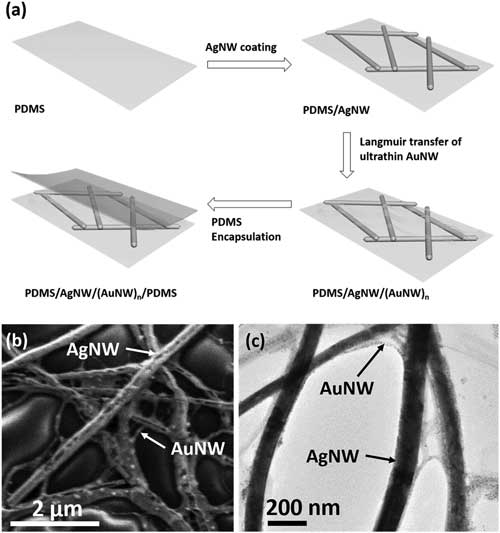| Posted: Jul 06, 2017 | |
Toward 'invisible' wearable sensors with gold nanowires(Nanowerk News) To build conformal contact of sensors with human skin/muscle with curvilinear surfaces, stretchable and bendable features are required – a capability impossible to achieve with existing rigid circuit board technologies. |
|
| To date, great progress has been utilized in fabricating skin-like strain sensors using a number of novel materials including metallic nanomaterials (metal nanoparticles, and metallic nanowires such as gold nanowires, silver nanowires, and copper nanowires), carbon nanomaterials (carbon blacks, graphene, and carbon nanotubes), and even ionic liquids. | |
| Researchers in Australia now report on a transparent and stretchable strain sensor using percolating networks of 'soft' gold nanowires (AuNWs) and 'rigid' silver nanowires (AgNWs) which are fabricated through simple and solution-processable approach. | |
| As they write in Advanced Functional Materials ("Percolating Network of Ultrathin Gold Nanowires and Silver Nanowires toward 'Invisible' Wearable Sensors for Detecting Emotional Expression and Apexcardiogram"), the combination of the two kinds of nanowires enabled simultaneous achievement of high conductivity, transparency, and stretchability which is difficult to obtain from single type of nanowires only. | |
 |
|
| a) Schematic illustration of fabrication process of stretchable transparent strain sensor based on a double percolating networks of 'soft' AuNWs and 'rigid' AgNWs. b) Top-view FE-SEM image of the AgNW/AuNW percolation network on elastomeric PDMS substrate. c) TEM image of AgNW/AuNW percolation network showing that the junctions of the AgNW are tightened by soft AuNWs acting as a soldering material. (© Wiley-VCH Verlag) | |
| The team successfully fabricated a highly sensitive, transparent, bendable, and stretchable strain sensor based on the novel percolating networks of the 'soft' AuNWs and 'rigid' AgNWs. | |
| With optimum sensor design, this sensor can achieve a high sensitivity with a gauge factor of 236.6 at low strain (≤5.0%), the ultralow strain detection as low as only 0.05% strain, the tunable transmittance from 58.7% to 66.7%, and the stretchability of about 70% strain while maintaining high sensing performance. | |
| Moreover, the hybrid AgNW/AuNW-based sensor shows excellent durability as it can withstand up to 1000 stretching cycles at 10% strain and features low energy consumption (functioning at a low voltage of only 0.1 V). | |
| Also reporting in this paper, the team further demonstrates the applications of their durable and transparent strain sensors in detecting human emotional expressions, respiration rate, and apexcardiograms. | |
| "The unique attributes of our sensors in conjunction with simple yet cost-effective fabrication process indicate their potential real-world applications in next-generation 'invisible' and 'unfeelable' wearable technologies," the authors conclude. |
 By
Michael
Berger
– Michael is author of three books by the Royal Society of Chemistry:
Nano-Society: Pushing the Boundaries of Technology,
Nanotechnology: The Future is Tiny, and
Nanoengineering: The Skills and Tools Making Technology Invisible
Copyright ©
Nanowerk LLC
By
Michael
Berger
– Michael is author of three books by the Royal Society of Chemistry:
Nano-Society: Pushing the Boundaries of Technology,
Nanotechnology: The Future is Tiny, and
Nanoengineering: The Skills and Tools Making Technology Invisible
Copyright ©
Nanowerk LLC
|
|
|
Subscribe to a free copy of one of our daily Nanowerk Newsletter Email Digests with a compilation of all of the day's news. |
